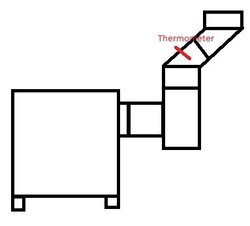johnstra said:
I monitor my flue temps closely and I worry about them being too cool. This picture shows my approximate setup. The probe is about 14" above the top of the stove, but it's offset. When my stove is running at 450 on the surface, my flue temps are around 300. I have to work very hard to get mine up to 600.
Something is funny then. I use a condar probe meter and every day run the flue past 1000 to keep it clean and burn off any funk from the startup. Easy peezy. Once running, in order to keep a clean burning fire, the probe meter indicates quite high (600-800) which might just be a shocking temp to some but do realize it is right in the freaking middle of the recommended burn temps on the face of the condar probe. If you can't run the flue temps this high then you need to consider wood size, wood dryness, and burn rate. Could just be that you need to run it harder, maybe your stove is oversized?
So here are a few reasons that the reported flue temps vary and why they vary with regards to stove surface temp.
1) Stone stove vs. steel. (I can be at 250 surface and 1100 flue, try that with a steel stove)
2) Cat vs. noncat (Cat flues will always be cooler once the cat is engaged)
3) EPA vs. smoke dragon (The dragons are capable of being choked down)
4) flue damper vs. clear flue.
5) probe meter vs. surface mount (This is the big one)
6) Folks burning clean vs. smoldering fires (to some folks you are supposed to smolder)
7) Reports of peak vs. sustained. (Sure, at times I am at 1000 or at 400 but mostly 600-800 during active burning)
8) Wet wood (you'll never get a good hot flue with wet wood)
9) oversized wood (also tough to get a hot flue)
10) location on flue being measured (I'm at 15" which is supposed to be equal to 18" on the directions from Condar, I called them first)
I love my probe meter. We use it more than the window to see how the fire is doing.



